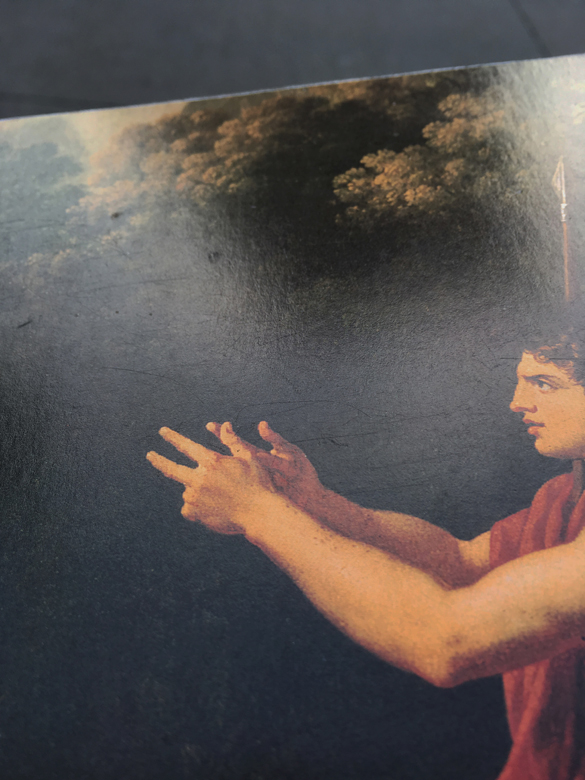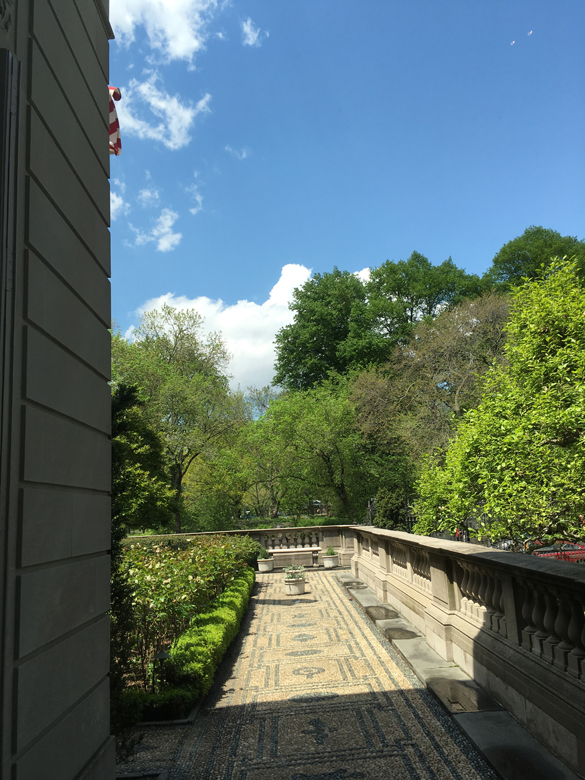CLV
Or is that Magna Palestina?
Meanwhile, back in Attica, c. 1971… or is that BCE?
The exceptional individual is our chief tool for enshrining social norms
Thus do a hundred schools of thought iris down to a single formula and a thousand flowers fade. And to think, they could have been contenders!
Let a hundred blossoms of thought unspool…
then, wind again,
lest a hundred schools of thought balloon…
Advice to someone arriving for their first visit to the U.S.:
Whatever anyone says to you, just say awesome!
On the afternoon of January 23, 1917, three months before the U.S. entered World War I, Gertrude Dick, a poet and former student of John Sloan, casually tested the door at the base of Washington Square Arch in passing and found it had been left unlocked. That evening, she led Sloan, Marcel Duchamp and three actors from the nearby Provincetown Playhouse up the iron spiral staircase to the summit of the arch. There, amidst a light dusting of snow, they spread out rugs, strung up balloons, drank wine, and read poetry. Sloan sketched the scene by the light of candles and Chinese lanterns. At midnight, the foregathered six – to the accompaniment of cap guns and a lengthy preamble consisting of multiple repetitions of the word “whereas” – declared Greenwich Village an independent nation.
Sloan later turned the sketch into an etching, Arch Conspirators. The view shows the group huddled in their winter clothes atop the arch, with a brightly-lit 5th Avenue receding into the background. He depicts himself drawing and smoking a pipe. Dick sits with her back against the inside wall of the pediment. She smiles up at a standing Duchamp, who is eating a sandwich.
In London, on the evening of April 6, 1580 occurred an earth tremor that drove frightened theatergoers into the street. Two days later, a ballad “intituled comme from the plaie,” was registered with the authorities.
Comme from the plaie
The earth quakes, lett us hast awaye…
Marcel Duchamp, artist, chess player, réspirateur, and arch conspirator. He is the younger contemporary of Charles Deschamps, a London art dealer. Did his ancestors have to pay extra for plural?
And again, you have a Jep Gambardella moment
Better to be in a tribe than a tribunal
There’s a difference between a void and a vacuum
Yet one should avoid the latter and embrace the former
Replete with emptiness
The head: Barack Obama ‘deliberately snubbed’ by Chinese in chaotic arrival at G20
The lede: The US president was denied the usual red carpet welcome and forced to ‘go out of the ass’ of Air Force One, observers say
Some body: China’s leaders have been accused of delivering a calculated diplomatic snub to Barack Obama after the US president was not provided with a staircase to leave his plane during his chaotic arrival in Hangzhou before the start of the G20.
Chinese authorities have rolled out the red carpet for leaders including India’s prime minister, Narendra Modi, the Russian president, Vladimir Putin, the South Korean president, Park Geun-hye, Brazil’s president, Michael Temer, and the British prime minister, Theresa May, who touched down on Sunday morning.
But the leader of the world’s largest economy, who is on his final tour of Asia, was forced to disembark from Air Force One through a little-used exit in the plane’s belly after no rolling staircase was provided when he landed in the eastern Chinese city on Saturday afternoon. When Obama did find his way on to a red carpet on the tarmac below there were heated altercations between US and Chinese officials, with one Chinese official caught on video shouting: “This is our country! This is our airport!”
“The reception that President Obama and his staff got when they arrived here Saturday afternoon was bruising, even by Chinese standards,” the New York Times reported…
…Obama suggested his Chinese hosts might have found the size of the US delegation “a little overwhelming”.
“We’ve got a lot of planes, a lot of helicopters, a lot of cars and a lot of guys. If you are a host country, sometimes it may feel a little bit much.” [Guardian online, 9/4/16]
And for its part, The New York Times:
HANGZHOU, China — Air Force One had a bumpy landing in Hangzhou on Saturday, but it was nothing compared with what happened after the plane rolled to a stop.
As the reporters who traveled to the Group of 20 summit meeting with President Obama from Hawaii piled out and walked under the wing to record his arrival, we were abruptly met by a line of bright blue tape, held taut by security guards. In six years of covering the White House, I had never seen a foreign host prevent the news media from watching Mr. Obama disembark.
When a White House staff member protested to a Chinese security official that this was not normal protocol, the official shouted, “This is our country.”
In another departure from protocol, there was no rolling staircase for Mr. Obama to descend in view of the television cameras. Instead, he emerged from a door in the belly of the plane that he usually uses only on high-security trips, like those to Afghanistan.
Witnessing the scene, Susan E. Rice, the national security adviser, looked baffled and annoyed. Joined by her deputy, Benjamin J. Rhodes, she ducked under the rope to make her way closer to the president. The two were immediately stopped by the same Chinese official, who angrily challenged them. Asked later what happened, a diplomatic Ms. Rice replied, “They did things that weren’t anticipated.”
As orthodox strategies and tactics evolved [in ancient China], methods of combatting them with unorthodox tactics also developed. Sunzi stresses the importance of both kinds of tactics. Zheng refers to normal, orthodox, or direct force and qi to the indirect, unorthodox, or extraordinary. They are interlinked concepts… Zheng can be a fixing or holding operation, while qi is a flanking or encircling operation. A qi operation is strange and unexpected, while a zheng operation is more direct, more obvious. Often the engagement occurs with zheng, while the decisive stroke, coming where the enemy least expects it, is qi. [From Tom Bisio, Beyond the Battleground, p. 6]

SHANKSVILLE, Pa. — Just another Thursday, and the morning mix includes leather-vested bikers from New Jersey, Amish visitors from Pennsylvania and a few children adjusting to a park not intended for play. They settle onto benches for the 11 o’clock retelling.
A ranger in the green and gray of the United States National Park Service tucks his peanut-butter-and-jelly lunch on a shelf and walks out to face his audience. A field of wildflowers undulates behind him; the pewter-bellied clouds seem nearly within reach. He begins:
“Remember how bad the weather was that morning?”
Hesitant nods turn quickly to head shakes. No. On that particular September morning, you could see forever.
This is just the ranger’s way of buckling you in. Helping some to remember what we already know. Helping others, especially those who were not yet born, to envision a beautiful, calamitous day now nearly 15 years in the past.
His name is Robert Franz, he is 61, and his title is “interpretive park ranger,” which means that his job is to tell the story of what happened in that color-dappled field behind him, again and again and again. This is the Flight 93 National Memorial, by far the most removed of the three 9/11 crash sites. A visit requires a roller-coaster journey through the arresting Allegheny Mountains, up and down and up and down, past a Confederate flag here, a Trump sign there, to a 2,200-acre field set aside for reflection.
“Mayday! Mayday! Get out of here!” the ranger says, echoing the alarm that was heard by air traffic controllers. The words chill the late-summer air, as children fidget and bees buzz about.
He continues the story of United Airlines Flight 93, bound for San Francisco from Newark. How four hijackers redirect the jet southeast, most likely to crash into the nation’s capital. How many of the 40 crew members and passengers fought back. How this hurtling jetliner nearly flipped before crashing at 563 miles an hour into the soft, strip-mined earth, killing all.
“The crew and passengers put democracy in action,” Mr. Franz says. “They take a vote” — to storm the cockpit and regain control of the plane.
Sometimes Mr. Franz stands at the memorial plaza, answering questions about the time of the crash and the location of the bathrooms. He commiserates as people recount their own connections to the day…
Sometimes he distributes Flight 93 Junior Ranger handbooks, explaining to young visitors what activities they need to complete before receiving a Junior Ranger badge. The 22-page booklet is a thoughtful study in trying to find the right words: Early in the flight, their plane was hijacked by four men. To hijack a plane means to take control over it. These hijackers were angry at the United States of America…
…But there are words, and then there are words. When children ask about the recovery of bodies, Mr. Franz redirects, ever so slightly. Since there were only remains, no bodies, he explains that a spot out there, beyond the wildflowers, is now “a final resting place.”
Vest-pocket putti
Scripts are for flipping
How’s the legroom on that flight to Shanksville?
A boxcutter is, technically, a kind of shank.
Shank outside the box
Shanksmare: a walking horror dream
The more energy one puts into reprehending, the less is available for comprehension
I was a National Parks Service Deranger for the…
In the Salon of 1861 appeared a very large oil painting by the Czech artist Jaroslav Čermák, Razzia de bachi-bazouchs dans un village chrétien de lHerzégovine (Turquie), which has since come to be known as The Abduction of a Herzegovenian Woman. The painting both continued the Classical genre of “rape” scenes, and cranked it up another level. Among other critics (the painting was awarded a prize), Théophile Gautier gushed like a firehose: “Mr. Čermák attracts the eye by means of a certain forceful and luminous brutality… the torso of the woman monopolizes the eye with the vivid brightness of tone and the spirited luxuriance of the flesh. It is a beautiful piece, this body full of strength, youth and health, lavishly female and with a satin sheen…
This exhibition is… the debut of Mr. Jaroslav Čermák. Immediately he knew how to distinguish himself from the crowd… At the Salon, it is not enough to have talent, one has to make sure that this talent is visible, or rather noticeable [voyant], to talk in the jargon of our time.”
N.B. Bashi-bazouks were irregular troops attached to the Ottoman army.
After the Salon, Abduction toured Europe and was eventually bought by Theodore A. Havemeyer in New York. In 1879, one Earl Shinn, born in Pennsylvania and raised a Quaker, and who later studied painting under Gérome and at the École des Beaux-Arts, published a volume of essays, Art Treasures of America (under the pseudonym Edward Strahan) in which he discussed Havemeyer’s collection in general and Abduction (which he calls Episode in the Massacre of Syria), in particular:
“Čermák, that admirable painter, unite[s] the keen objective perceptions of the Gypsy with the refinements of western culture… His present picture is a noble… and monumental pyramidal composition… of a woman struggling in the arms of soldiery. Her towering white form rises in a superb attitude of stormy grace, as she strives, with the strength of a grand and richly-developed nature, to free herself from the grasp of the warlike captors.
Her husband, slain at her feet, still grasps convulsively the hem of her garment. A lusty babe, also dead, lies near by. Alone now on earth, with nothing to live for but honor, she concentrates her thoughts on the single idea of liberty, and struggles with hands and feet to free herself from the powerful foes who are carrying her away captive.
Her posture, in this great passion of energy, is full of native grace, the rich beauty of the animal nature asserting instinctively its wild sense of justice. While and old soldier guards the door with his sword against intruders, a powerful shaven-headed infidel clasps her with fell purpose in the rigid vise of his wiry arms, and another begins to tie her wrists. One beautiful arm – alas that so soft a limb should feel the outrage of a rope! – is already encircled with its hempen manacle, though she brandishes it aloft with all her strength.
The other hand and arm, white as the swan’s wing, are resolutely battling with the Moslem monster who imprisons her in his grasp; the convulsive movements of the beautiful feet add to the dramatic expression of the figure, which equals, in artistic technical beauty, in rich morbidezza, in sinuous and flexible grace combined with robustness, the most daring sculpture of John of Bologna or any of the complicated designers of the Renaissance.
All around her, the white Rubensesque grandeur of her torso, and forming a rich foil, are relieved the dark skins and braided garments of her captors, who themselves yield us glimpses of savage tawny faces, in the highest degree spirited and expressive.
At the foot of the unhappy captive lies her carved crucifix, whose string has been torn from her neck in the struggle; so that she rises, and aspires, and battles, and achieves, like a living allegory of Christianity, – assailed, insulted, borne hither and thither, but not yet conquered…”
Welcome to the Shanksmerican Dream
The soft, strip-mined earth…
Morbidezza
No bodies
Only remains
Edward I, also known as Edward Longshanks, and Malleus Scotorum (“The Hammer of Scots,”) was King of England from 1272 to 1307…
I know thee well – a serviceable shanksvillain…
Let’s rôle

